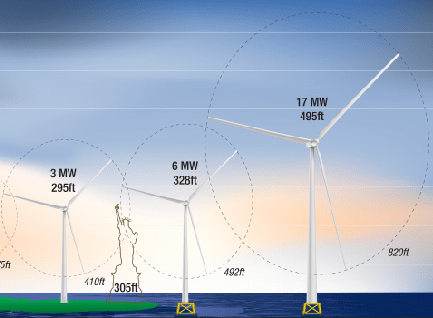
More and more wind turbines are reaching the end of their operational lifetime. Europe has 290 GW of wind energy. 80 GW of that will reach the end of its theoretical operational lifetime by 2030. Most will in fact continue operations. Some will be decommissioned. The European wind industry has self-imposed a landfill ban for wind turbine blades. So what is Europe going to do with these blades once they are decommissioned? WindEurope’s new circularity hub showcases existing methods to reuse, repurpose, recycle and recover wind turbine blades.
Sustainability has always been part of wind energy’s DNA. Wind is one of the most sustainable forms of electricity generation. Wind turbines have near-zero water consumption, minimal environmental footprint and a short energy payback time of just a few months.
This sustainability approach includes the decommissioning and recycling of wind turbines. Around 90% of a wind turbine’s mass is recyclable using established waste management practices. The last remaining challenge on the way to circular wind turbines are the blades which are made of durable and hard-to-separate composite materials. Many of these blades are not recycled yet after decommissioning.
So, where do blades go when they are taken down? Landfilling these blades is not an option. The European wind industry has committed to a self-imposed landfill ban for wind turbine blades effective as of 1 January 2026. Over the last years the industry has proactively developed new methods to reuse, repurpose, recycle, and recover decommissioned wind turbine blades.
More waste, more solutions
Of the 290 GW of wind energy capacity installed in Europe today, around 80 GW will reach the end of their theoretical operational lifetime by 2030. Many will be able to continue operating. But an increasing number will be decommissioned. WindEurope estimates that the annual volume of decommissioned blade material will increase to 55,000 tonnes a year by 2030. This increase from around 20,000 tonnes in 2025, is mostly driven by decommissioning in established wind energy markets like Germany and Spain.
This number poses a big challenge: the European wind industry has to scale up its circularity efforts. And it is doing just that. With the increasing volumes of decommissioned blades, new waste management practices are emerging. More and more companies are getting involved in reusing, repurposing, recycling, or recovering wind turbine waste. A new part of the wind energy value chain is in the making, creating new job profiles and employment opportunities.
New circularity hub
WindEurope has set up a new circularity hub to showcase the latest solutions, making the vision of circular wind energy a reality. European companies are investing in new facilities and championing creative and innovative solutions for decommissioned blades. The different examples illustrate sustainable second-life solutions that are already available today.
Circular Economy Act: waste management in the spotlight
Next year the European Commission will present a Circular Economy Act to strengthen sustainable waste management practices. The European wind industry in this context calls for a new set of waste codes. Currently wind turbine waste is not labelled as such and often mixed with other forms of construction waste. This makes it harder to trace blade waste and treat it adequately. To avoid this problem, the European Commission should create dedicated waste codes for decommissioned wind turbine blades and for permanent magnets.
EoLIS 2025 – experts meeting in Lisbon
On 20-21 November 2025 experts from the entire value chain of wind energy come together to discuss end-of-life solutions for wind turbines at EoLIS 2025. Around 300 experts will discuss anything from repowering to decommissioning and recycling. Find more information on the event and register now.
KeyFacts Energy Industry Directory: WindEurope l KeyFacts Energy: Decommissioning news
 KEYFACT Energy
KEYFACT Energy